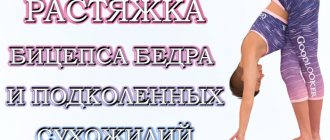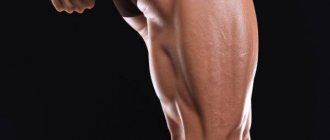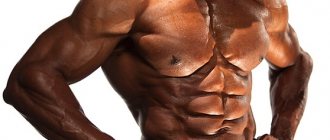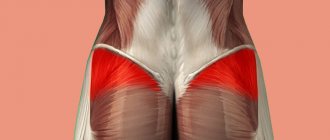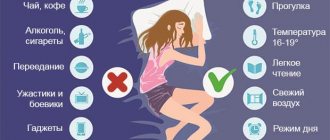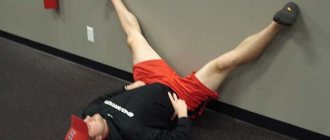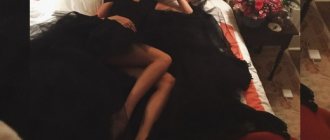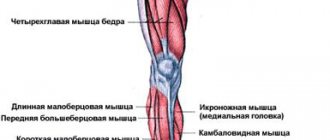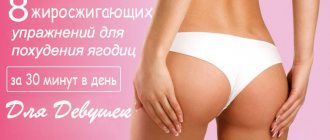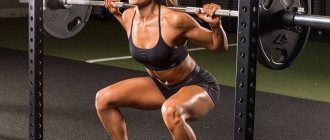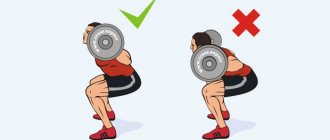Often intense workouts leave behind not only strong and beautiful muscles, but also nagging pain and tightness. These sensations are familiar to everyone who has connected their life with sports in one way or another.
Stretching will help you cope with them.
Many are accustomed to the classic version of this workout, but master of sports in powerlifting Denis Vovk and bodybuilder Ruslan Safarov suggested trying their own. Important!
A set of exercises with a barbell is worth doing if you are already a fairly experienced athlete. And it’s better if you have a partner in the gym to insure you.
Denis Vovk
master of sports in powerlifting
Don't use too much weight for these exercises. Start from your own feelings and capabilities.
Barbell stretch for back and hips
Bends while sitting
- We put a bench under the bar with a bar and sit on it.
- We place the bar on our shoulders.
- We move away from the rack, without removing our hands from the bar.
- Toes are spread apart, knees point parallel to toes. The shoulder blades are retracted.
- From this position we lower the body to the bench.
- It is advisable to touch the bench with your chin, but it all depends on your level of stretching.
- We go down slowly, we get up more dynamically.
- The back remains straight throughout the entire exercise.
Deadlift with snatch grip
- Place a barbell with weights on the floor.
- We stand next to the bar, feet shoulder-width apart, toes slightly turned out.
- Bend your legs slightly and grab the bar with a wide grip. The back is completely straight.
- We tear the bar off the floor and pull using the back until it is completely straight.
- We lower the bar back slower than we raised it.
Photo: istockphoto.com
Double twist
The exercise is performed standing and is aimed at relaxing and relieving pain in the back of the thigh.
.
A) You need to stand straight and then lean forward. The knees remain straight.
B) Stretch towards the floor at the toes of your feet, then move towards your knees.
Advice:
Be sure to keep your knees straight and your quadriceps tense.
Stretching the back, shoulder joint and hands
Overhead squat
- Take the empty bar with a medium grip and lift it above your head.
- The legs are shoulder-width apart and the toes are slightly turned to the sides.
- Slowly lower your pelvis and bend your knees to the level of a deep squat.
- As your shoulders get used to it, you can bring your arms narrower and narrower.
Front squat using straps
- We fix the empty bar on the hands with straps.
- We throw it over the chest and the front of the shoulders.
- At the same time, the brushes bend outward.
- In this position we squat with the bar.
- You can ask your partner to belay you and support your elbows extended forward.
Lifting the bar behind the head while lying down
- We lie down on the banquette.
- Raise the bar up.
- We fix the elbows in an extended position.
- We begin to lower our hands with the bar behind our heads.
- Slowly move the bar slightly lower than head level.
- Raise your arms back to the starting position.
Important!
When performing the exercise, partner insurance is required.
Photo: istockphoto.com
Stretching the muscles of the hamstrings: standing
The exercise is aimed at relieving pain in the buttocks and back of the thighs
A) Place your foot on a bench or any other elevated surface
B) By tilting your body towards the foot of the leg located on the bench, reach for it.
C) Hold this position for 15-20 seconds, and then change your leg to the other.
Advice:
choose the right elevation - it should not be too high. Keep your knee straight, and you can move your pelvis slightly forward - this will enhance the effect of the stretch.
Hitch
Shoulder stretch
Exercise 1
- The partner lies down on the gymnastics mat on his chest. Places his hands along the body.
- We bend over to him and take his hands in ours.
- Holding your partner’s torso with your knee, we raise his arms as vertically as his stretch allows.
- At the same time, we bring them slightly towards the center.
- We perform the exercise smoothly and without sudden movements.
- We change places.
Exercise 2
- The partner lies on his chest on a gymnastics mat.
- He clasps his hands and places them on the back of his head.
- We bend over our partner and take him by the elbows.
- Holding your partner’s torso with your knee, pull his elbows up.
- We do everything very carefully and without sudden movements.
- We change places.
A set of exercises to work the back muscles from a master of sports in bodybuilding
Training for men to pump up the pectoral muscles
Back stretch
Exercise 1
- The partner lies with his chest on a gymnastic mat.
- He stretches his arms above his head and clasps them in a lock.
- We approach him from behind and take his hands in ours.
- We lift our partner up by the arms so that his torso comes off the floor.
- We rest our knee on the partner’s lower back and continue to pull his hands towards us.
- We change places.
Exercise 2
- The partner stands in the “bridge”.
- We approach him from one side and, supporting him under the lower back, lift him with light rocking movements.
- We repeat this on the other side.
- We change places.
Photo: istockphoto.com
Front thigh stretch
- We sit on our knees so that our feet are on the sides of our pelvis.
- We lower the pelvis to the floor.
- Slowly we lower ourselves onto our backs.
- We try to pin her to the floor.
Jumping Lunges
The combination of aerobic and strength training will have a wonderful effect on tightening your figure. The complexity of the execution due to jumping is quite high .
more about 7 types of different lunges here.
In addition to the main muscle group being worked, lunges will help tighten the buttocks and calf muscles.
- Starting position – Legs together, back straight, arms at your sides, gaze directed forward;
- As you inhale, lunge forward with your right leg, exhale while hovering;
- On the next inhalation, we jump and land in a lunge on the other leg.
Learn more from the video:
You can do this exercise with or without weights. For beginners, you should start with 10-12 repetitions on each leg in 2-3 sets.
For the necessary coordination of movements, help yourself when jumping with characteristic swings of your arms.
Stretching rules for figure skaters
*Do your stretching in a warm room. Stretching outdoors can cause injury. That's why experts recommend stretching at the end of class: after you've taken off your skates, gone outside, and changed into dry clothes.
*Do the exercises at a calm pace. Avoid jerking - this can again lead to injury.
*Watch your breathing . Try to perform the main effort while exhaling: when we breathe deeply and evenly, the muscles relax faster.
Video
1Did you like the article? Share with friends:You may also be interested in Treatment 0
Treatment of hip diseases at home Hello, dear visitors! From our review you will find out which hip joint treatment is used and Treatment 0
X-ray of the hip joint in a child and an adult Hello, dear visitors! In today's review we will find out what a hip x-ray is. Treatment 0
Restoration of hip joint cartilage Hello, dear guests of the site! Problems with the musculoskeletal system can occur not only in the elderly, Treatment 0
Displacement of the hip joint: symptoms and treatment in adults Good day, dear site visitors! In this review we will find out what Treatment 0 is
Causes, symptoms and treatment of hip cysts Good day! Joint problems are quite common and cause a lot of inconvenience. Attraction 0
Pinched nerve in the hip joint: symptoms and treatment Good day, dear visitors! Shooting pain in the thigh area is a negative sign that
Comments: 1
- Vladimir 01/14/2021 at 13:10
Thank you for the good yoga lesson, I’m 64, my joints hurt, my mobility is limited, and at times I have acute pain in my left hip. I will practice your exercises.Answer
Add a comment Cancel reply
Name *
Email *
Comment Search: Site headings
- Diseases
- Treatment
- Rehabilitation
- Endoprosthetics
- About the site
- All articles
- Feedback
- Privacy Policy
- Terms of use
textarea>header>header>header>header>header>header>
The essence of physical training
The main problem that activates the process of destruction of the hip joint is a decrease in the amount of synovial fluid. The glands of the shell of the same name, lining the articulation cavity, are responsible for its production. As soon as there is less synovial fluid, the mobility of the articular surfaces is impaired and the friction between them increases. This leads to a narrowing of the joint space, which in severe situations completely immobilizes the patient. This is how arthrosis of the hip joint occurs.
This is a real image of the femoral head with stage 2-3 arthrosis. Look carefully and think, will gymnastics help in this case?
Medicines can slow down the progression of the disease, but the process cannot be stopped. At an unfavorable moment, arthrosis will lead to serious pain, which will significantly affect the quality of life. However, even at the moment when it becomes clear that endoprosthetics surgery is no longer possible, therapeutic exercises will prove extremely useful for improving the functioning of the joint, both before and after surgery.
The effect of exercises carried out at home is as follows:
- stimulation of blood flow around the damaged joint;
- restoration of muscle performance and prevention of muscle atrophy;
- stimulation of the glands of the synovial membrane due to intensive blood supply;
- reducing the progression of arthrosis;
- stretching and mobilization of the ligamentous apparatus;
- general strengthening of the body and immune system.
After any gymnastic exercises, the mood improves, which leads to an increase in a person’s ability to fight the disease.
SYNERGEL
— the healing power of 4 natural poisons will quickly relieve joint pain!
Get Synergel on promotion only
Old price: 4790₽
New price: 147₽
Contactless delivery and safe receipt of your order!
A network of blood vessels that supplies tissues with useful substances that promote rapid regeneration of the cartilage surface.
However, not only the psychological factor influencing the patient plays a role in activating restoration processes in the hip joint. There are also quite tangible changes that the patient will feel after treatment through regular exercise. These include:
- increased range of motion in the joint;
- pain relief;
- increased strength in a limb;
- easier walking;
- reduction in the frequency of colds;
- improving quality of life.
Although gymnastics will not radically change the situation, the joint will still have to be replaced with prosthetics; it will help reduce rehabilitation time and speedily restore motor activity in the postoperative period. This will be possible thanks to developed muscles and well-developed tendons, as well as stable blood flow in the hip joint.
There are many options for gymnastic exercises done at home. But the effectiveness of their treatment is completely different. The most relevant training is that proposed by a professional exercise therapy instructor, as well as the classic methods of Evdokimenko and Bubnovsky. A video of classes with a physical therapy specialist clearly shows the optimal set of exercises.
Minimally invasive endoprosthetics in the Czech Republic: doctors, rehabilitation, terms and prices. Find out more
Conservative treatment
In most cases, for severe pain, the doctor prescribes complex analgesics, as well as anti-inflammatory drugs. It is allowed to use ointments with a cooling or, conversely, warming effect (which one is decided by the doctor). Additional medications are prescribed depending on the symptoms and other characteristics of the injury.
More often, a traumatologist prescribes:
- Ibuprofen or Aspirin. These drugs are anti-inflammatory and painkillers. These medications also relieve swelling.
- Heparin ointment, Nicovenna. These compounds have a cooling effect. Thanks to such ointments, you can reduce pain and swelling. These products contain analgesics and essential oils. The use of such medications does not increase the patient's body temperature.
- Nicoflex or Dolpic. These are warming ointments that are usually used during the rehabilitation period. That is, it is better not to use such drugs immediately after injury, as they can aggravate the inflammatory process. Warming ointments contain bee or snake venom. This type of medicine dilates blood vessels.
- Pain relieving ointments. The most effective remedy is Traumeel S, Fastumgel. These topical medications contain ibuprofen and other anti-inflammatory and analgesic components. This type of medication can be used immediately after an injury and during the rehabilitation period.
In more complex situations, the patient is prescribed immobilization. To do this, the victim’s leg is fixed using special devices. Severe sprains with serious muscle damage may require surgery.
Typically, surgery is performed when structures are torn. Also, similar measures are carried out if deformations were detected during diagnosis.
Gymnastics Evdokimenko
Since the early 2000s, Dr. Evdokimenko’s practice of therapeutic exercises has become widespread in medical practice. Today he is a well-known rheumatologist, a specialist in joint restoration through physical training. Has the status of academician at one of the Moscow technical universities. His medical career began in 1984, when the future specialist received a paramedic education. The further period is associated with practical work and study at the institute, which Pavel Evdokimenko graduated from in 1994. From that moment on, he chose the direction of physical therapy for various osteo-articular pathologies as his specialization.
Pavel Evdokimenko.
Further work at the arthrosis center in Moscow, and then subsequent improvements at the Research Institute of Rheumatology of the Russian Academy of Medical Sciences, prompted the doctor to develop a set of exercises that help prolong the active function of the joints. In 2003, the first book was published, telling in detail about the method of Pavel Evdokimenko. Today, exercise is recognized throughout the world and helps slow the progression of coxarthrosis. Even in the most difficult situations, when surgical intervention is already inevitable, the use of therapeutic exercises can dramatically reduce postoperative rehabilitation.
Although gymnastics can heal arthrosis, it cannot completely replace the installation of a prosthesis. However, there are significant positive qualities that are discussed below.
- Strengthening the thigh muscles. The less their atrophy, the easier it is to move the limb. A strengthened muscle frame will help reduce the load on the painful joint, thereby slowing down the progression of arthrosis.
- Activation of blood flow in the synovium. Improving the blood supply to the affected hip helps reduce the rate of reduction of the joint space. This is achieved by increasing the production of synovial fluid. As a result, friction in the joint is reduced and functionality is increased.
- Reducing osteoporosis. Achieved by increasing active movements in the joint. The processes of rarefaction of bone tissue are reduced, as the work of osteoblasts is activated.
- Strengthening the back frame. Since physical training stimulates muscle activity not only in the thigh, but also in the buttock and lumbar region, the load on the affected joint and spine is further reduced. This makes movement easier and also relieves pain.
- Increasing joint resistance to physical stress. This is achieved through long training.
- Easy adaptation in the postoperative period during joint replacement. Since the muscles, as well as the ligamentous apparatus, are in an optimally developed state, even the first steps after surgery are easier to bear, and rehabilitation will be short and painless.
Gymnastics video:
All exercises according to Evdokimenko’s method are performed many times. No major changes in the joint will occur within a month of training, so you need at least six months. But the systematic use of gymnastics promotes significant clinical improvement. The patient will feel a significant improvement in walking, as well as a decrease in pain.
